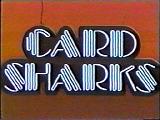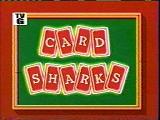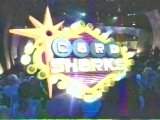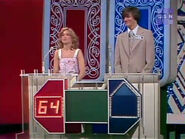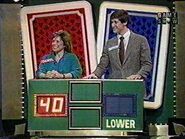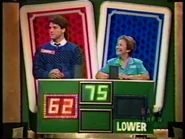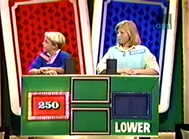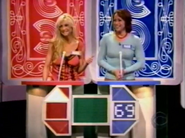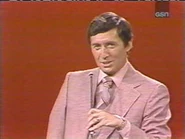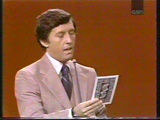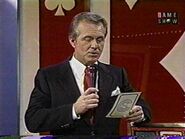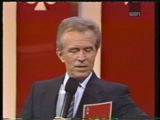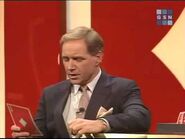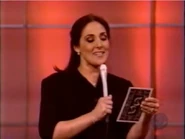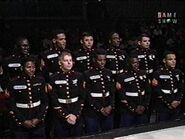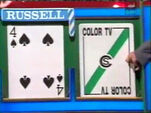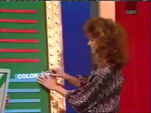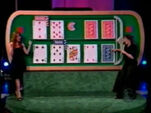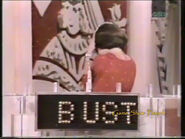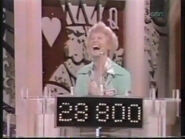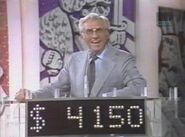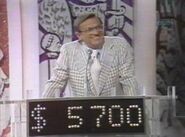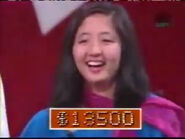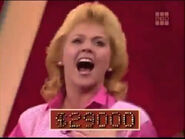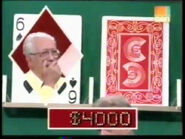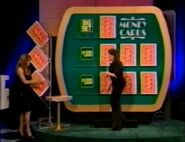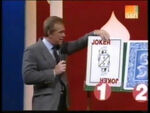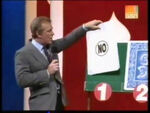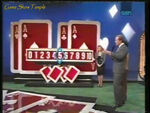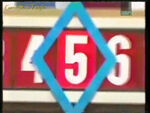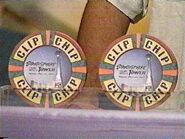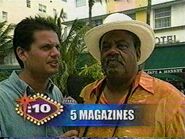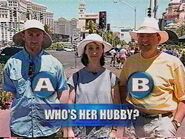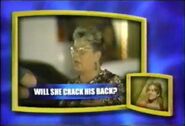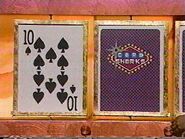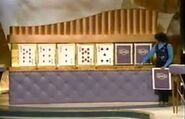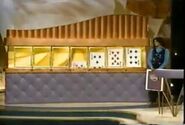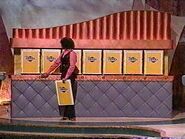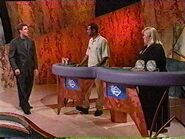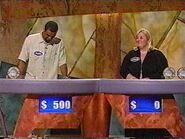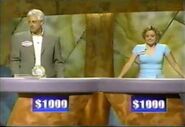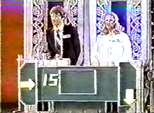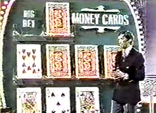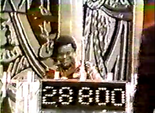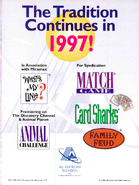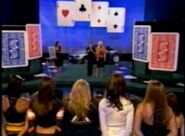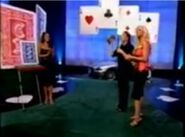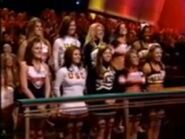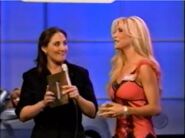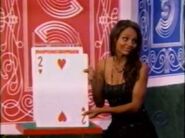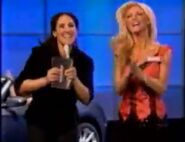| Hosts | |
|
Jim Perry 1978-1981 (NBC) | |
| Dealers | |
|
Janice Baker, Lois Areno, Ann Pennington, and Markie Post 1978-1981 | |
| Announcers | |
|
Gene Wood 1978-1981, 1986-1989 | |
| Sub-Announcers | |
|
Bob Hilton | |
| Broadcast | |
| Two pilots: 3/17/1978NBC: 4/24/1978 - 10/23/1981CBS: 1/6/1986 - 3/31/1989 Syndicated: 9/8/1986 - 5/29/1987Pilot ("Card Sharks '96"): 1996 Syndicated: 9/17/2001 - 12/14/2001CBS (Gameshow Marathon): 6/14/2006 | |
| Packagers | |
| Mark Goodson-Bill Todman Productions (1978-1981) Mark Goodson Productions (1986-1989) FremantleMedia (2006) | |
| Distributor | |
| Television Program Source (1986-1987) Pearson Television (2001-2002) | |
Card Sharks, the game show where two contestants played high-low with the cards in order to win lots of money.
Main game
Two contestants competed against each other on all versions of Card Sharks. Each contestant was assigned a row of five oversized playing cards. Each contestant had a standard 52-card deck; the ace ranked highest and the deuce (two) ranked lowest. The champion played the red cards on top, while the challenger played the blue cards on the bottom. In case of two new players, a coin toss was used to determine who played red and who played blue.
Toss-up questions
Control of the board was determined by asking a survey question similar to the surveys done on Family Feud. Questions were posed to 100 people of the same occupation, marital status, or demographic (“We asked 100 teachers, ‘Has a student ever given you an apple?’ How many said yes?”). The contestant who received the question (with the red-card player, usually the champion, going first) then gave a guess as to how many people gave the answer that the host gave (and usually his/her reasoning, although this is not required). After hearing the guess, the opponent had to choose whether the correct number was higher or lower than that guess. Choosing correctly gave control of the board to the opponent; otherwise, the initial contestant gained control. The initial contestant would also gain control of the board if he/she correctly guessed the survey answer.
Starting in Fall 1980 and continuing through the end of the Eubanks version in 1989, an exact guess won a $500 bonus for the contestant; the contestant keeps it regardless of the game's outcome. Up to four (three in game two in the early part of the Rafferty version) toss-up questions were played per game.
In addition to the regular 100-person survey questions, some questions on the Eubanks/Rafferty versions used one of the following formats as opposed to the straight 100-person survey.
- 10 Studio Audience Members: Beginning on July 7, 1986 questions were asked about a panel of 10 audience members sharing a common profession or characteristic (mothers-to-be, nurses, students) who taped an entire week of shows (originally, five different poll groups were used per week). An exact guess by the contestant won $100, and the panel members each received $10.
- Educated Guess: Introduced on October 6, 1986, and the only time non-survey questions were ever used on the program. Each question was general knowledge with a numerical answer ("In miles per hour, how fast is the fastest snake?", "How old is Bill Rafferty?"). Originally answers only ranged from 0-99 (the range of the readouts on the contestant podium). This changed in 1987 to questions with various ranges. To accommodate the change, values would be superimposed with on-screen graphics or written on cards by the contestants. An exact guess on this kind of questions also won a $500 bonus.
The numerical answers usually appear in a sportstype display, but in the Gameshow Marathon show, the answers appeared in an eggcrate display.
Playing the cards
Beneath each contestant's row of cards was a moving bracket bearing the contestant's name which would mark one of the cards as the "base card". Each contestant's base card was the first card in the row of five. The winner of the question could choose to either play and keeping his/her base card, or have it replaced with another card from the top of the deck. The contestant then guessed whether the next (face-down) card in the row was "higher" or "lower"; if correct, he or she could continue to guess the next card after that and so on (if both cards were the same, the guess counted as incorrect).
On an incorrect guess, the contestant loses his/her progress and returns to the base card with the other revealed cards being discarded and replaced by new face-down cards before the next question in the round. In this event, the opponent received a free chance to play his/her own row of cards but could not change the base card.
Contestants could also choose to "freeze", thus making the last revealed card the new base card and preventing the opponent from receiving a free chance. In the 1978-1981 run, the player's bracket or freeze bar connected to his/her name electronically moved by itself. Sometimes, the freeze bar is broken and when that happened, a handheld freeze bar was placed on the new base card. While in the 1986-1989 run, manual freeze bars were used.
If neither contestant guessed all the cards on his or her row correctly, another toss-up question was asked and the same procedures were followed until someone revealed all the cards in the row or the fourth question in the round was asked. In the final months of the NBC run, a $500 bonus was awarded for guessing correctly on all four cards in a single turn without freezing.
$100 was awarded for each game won, with two games winning the match and the right to play the Money Cards bonus game.
During most of the Rafferty version no money was awarded for winning a game or the match. Instead, several "prize cards" were shuffled into the deck consisting of trips (up to $6,000), furniture, appliances, and cash ($250, $500, $1,000, and $5,000; every amount except $500 was later removed). If one of those turned up during a player's turn, the name of the prize was placed on that player's side of the board adjacent to his/her row of cards and another card would be dealt which he/she had to call. Only the contestant who won the match claimed the prizes found.
Sudden death
The fourth question (third in the tiebreaker round) in each round was a "sudden death" question in which someone would win the game on the next turn of the cards. Whoever won control of the board had the opportunity to play the cards (and could change the base card if desired) or pass them to the opponent (who could not change the base card and had to successfully clear the remainder of the row). If either contestant guessed incorrectly, their opponents automatically won the game.
Tiebreakers
If the match was tied after two games, a tiebreaker game was played to determine the winner. Contestants played rows of three cards instead of five, and three questions were asked instead of four (two during one point in the '80s syndicated version), with the third being sudden death.
Beginning on January 4, 1988, the tiebreaker was changed to one sudden-death question; this also determined the winner of the match on the finale of the Rafferty version, as well as the final match of that version's Young People's Week. In the one-question tiebreaker game, both base cards were revealed so the player could make an easier decision as to play his/her cards and change the base card or pass to the opponent, who was not able to change the base card. As before, if either contestant guessed incorrectly, their opponent automatically won the match.
Money Cards
The winner of the main game played the Money Cards bonus game for a chance to win additional money. The Money Cards board consisted of seven cards on three rows; three cards were dealt on the bottom two rows, and one card was dealt on the top row. On the NBC version, the winner's first base card to begin the bonus game was dealt from the deck after the seven cards were placed. In the pilot, Jim took the top card himself, while in the series, the dealer gave it to Jim. On the CBS version, however, the first four cards were dealt on the bottom row, with the first card as the base card, followed by three on the middle row, and one on the top row (so in reality, this version dealt 8 cards out at the start instead of 7—11 if the three reserve change cards are included).
In addition to guessing whether a card was higher or lower, the contestant had to wager money on that prediction. The contestant was given $200 to bet with and had to wager at least $50 (and in multiples of $50) on each card on the first two rows. The contestant won money for each correct guess and lost money on each incorrect guess.
After completing the first row, or if the contestant "busted" (lost everything on that wager), the last card was moved onto the second row and the contestant was given an additional $200 (raised to $400 in 1986). The contestant had to play three more cards before reaching the last card on the top row, known as the "Big Bet". If a contestant busted prior to reaching the Big Bet, the game ended. Upon reaching the Big Bet, the contestant was required to wager at least half of their earnings; there was an occasional "25" or "75" at the end if a contestant had, at minimum, $50 or $150.
The most a contestant could win on the NBC version was $28,800, which was done once in the entire show's run by contestant Norma Brown (it was also done on the 1978 version's second pilot). Contestants could win up to $32,000 on the Eubanks/Rafferty versions, but was never won. The highest win on that version (and the overall record) was $29,000.
The maximum payoff was increased to $144,000 for a contestant at home during Gameshow Marathon.
Rule changes
Originally, only the first card on the bottom row could be changed. In mid-1978 the rule was changed so that the first card on every row could be changed. In the Eubanks/Rafferty versions, the contestant was given three opportunities to change a card by choosing one of three pre-dealt cards. Originally, a player could change more than one card on a row, and could even change more than once on the same card; this was later modified to allow the contestant to change only one card per line. The second syndicated run used the NBC change rules.
Duplicate cards (for example, two 8s in a row) originally counted as an incorrect wager. About two months after an incident in which all four 3s in the deck came up in a row,[1] [2] as well as a separate incident involving all four Jacks in the deck,[3] this was changed on October 20, 1980 so that the contestant neither won nor lost money if a duplicate was revealed (referred to as a "push" by Eubanks and Rafferty, and a "double" by Perry).[4] From then on, hosts encouraged the contestant to wager everything on an Ace or deuce since there was no way the contestant could lose with either card. The Pat Bullard run initially treated a push as neither a win nor a loss; however, it was later changed to a loss.
On the Gameshow Marathon version, the best-known rules to the Money Cards were brought back. A player started with $1,000 in betting money for the first two rows, and had to wager at least half the money on the Big Bet. Minimum bets were still $50, and players could change one card per line by using one of the three pre-dealt cards in the numbered slots. The "push" rule was also brought back but was not needed.
Sequences of Top Prizes
1978-1981
| $14,400 | $28,800 | ||
| $1,800 | $3,600 | $7,200 | $14,400 |
| $200 | $400 | $800 | $1,600 |
1986-1989
| $16,000 | $32,000 | ||
| $2,000 | $4,000 | $8,000 | $16,000 |
| $200 | $400 | $800 | $1,600 |
Car games
Starting on the syndicated version September 29, 1986 and on the daytime version October 27th, a second bonus round following the Money Cards was added to give players a chance to win a new car. Originally, the round was played using Jokers; the contestant earned one for winning the match and could win more if any of three additional Jokers that were in the Money Cards deck came up, which were set aside and replaced with the next card off the top of the deck. The contestant then placed the Joker(s) in a rack of seven numbered cards; if any of the chosen cards revealed "CAR" after it was turned over (the other cards read "NO" in much smaller lettering), the contestant won the car. The Jokers must be placed Joker side up; should the contestant place them face down, either the host would remind the contestant or turn the card over himself (sometimes with dealer assistance).
During the special weeks when children played, the top prize was usually a trip to Hawaii or a prize package featuring a boat (with either "WIN" or "HAWAII" displayed on one of the cards). The children received two Jokers to start; this meant there were two more in the Money Cards deck, which were set aside and replaced with the next card off the top of the deck.
On the last episode of the Rafferty version, all four Jokers were given to the final champion at the outset.
Beginning on July 4, 1988 the car game was changed to use the audience-poll group. The question was played the same way it normally would during regular gameplay, with the contestant predicting how many of the poll group gave a certain answer. For the bonus round a prop with a dial was used, and the contestant moved the dial to lock in his/her guess. A correct guess won the car, and missing by one either way won $500 (except during "Young People's Week" and the final episode when being one away also won the car). All other incorrect guesses won nothing more.
Returning champions
On the original series, contestants could return until losing a match or winning seven consecutive matches, with a maximum potential payout of $203,000. There technically was no winnings limit since NBC games, with few exceptions, did not have cash limits as CBS and ABC did.
On the Eubanks version, the maximum was either five matches or passing the CBS winnings limit (originally $50,000, increased to $75,000 in Fall 1986). The same rules applied for the Rafferty version, including a (never-specified) winnings limit; Brian Hunt was the only contestant to exceed this limit, winning $63,105 in cash and prizes (including two cars) in 1986, making him the biggest winner in the show's overall history.
In addition to the above, a rule concerning car wins was in place on the Rafferty version and adjusted twice during its run:
- For the first few weeks after the car game was introduced, a player retired immediately after winning a car. During this period General Motors supplied high-end luxury and sports car models.
- When GM started supplying mid-range priced sports cars the limit was adjusted again, with a contestant being allowed to win three cars before retiring.
- Halfway through the run (and staying through the remainder of it) the show began offering base models from American Motors through its Jeep and Renault brands, and adjusted the limit again to two cars.
2001 version
Main game
The gameplay was drastically different from the successful incarnations of the 1970s and 1980s. Four players competed, two at a time, in a best-of-three match. Each round used a single row of seven high-low cards.
Perhaps the most jarring difference was the lack of survey, educated guess, and "10 audience members" questions used on the previous versions; instead, one player started the game in control of the cards and kept control as long as they kept guessing correctly. An incorrect guess passed control over to the other player unless it was on the last card of the row, when it meant an automatic loss for the player who guessed it wrong.
All four players were given two "Clip Chip" tokens to start the game, and if one of them wanted to change the card in play they would place the token in a slot on their podium. A video clip would play, with one of three possible options:
- A situation (a la Candid Camera or Street Smarts) which was stopped before its resolution.
- Someone introduces himself/herself and then asks which of two others he/she is associated with.
- Someone trying to list answers related to a topic within 10 seconds, or sing the correct lyrics to an obscure song.
Correctly predicting the outcome of the clip allowed the contestant to change the card, while an incorrect answer did not.
Each game was worth $500. As before, two games were needed to win the match. The winner received a total of $1,000. The loser received an Argus digital camera as a consolation prize in addition to the $500 if they won a game.
The third game, if necessary, was played similar to the tiebreaker on the original Card Sharks with three cards. The difference, other than the fact that there was only one row of cards used, was that no Clip Chips could be used.
The two match winners then squared off in the Big Deal, one final row of seven cards. Clip Chips, if the players had any left, were still in play. Whoever won this final showdown won an additional $1,100 and advanced to the Money Cards. The loser of the Big Deal won a consolation trip to Las Vegas in addition to their previous $1,000.
Money Cards
This version's Money Cards differed from the original three versions.
The Money Cards board was pyramid-shaped. Three rows of cards (three cards on the bottom row, two cards in the middle and one card on the top) were dealt, with the last card on the top row called the "Major Wager" (an updated version of the "Big Bet" seen in earlier versions).
The day's champion's $2,100 were equally divided among each of the three rows ($700 per row).
Just as in the original NBC version, the winning contestant can change the base card on each row.
The contestant began with $700 on the bottom row. The top card from the deck was placed at the start of the row and shown to the contestant, who then made a wager based on whether he/she thought the next card was higher or lower, with a minimum wager of $100. Wagering continued until the contestant played the three cards on the bottom row or busted.
The last card on the bottom row was moved to the left of the middle row and the contestant received an additional $700. The contestant then played the next two cards as he/she did on the first row, wagering as he/she went along.
The last card in the middle row was placed next to the card on the top row for the final bet, the "Major Wager", and the contestant received an additional $700. The minimum bet on this card was at least half of the contestant's current total. The maximum total possible was $51,800.
Contestants could only change the base card on each row. A tie (push) originally returned the amount wagered to the contestant (as had been the case since late 1980), but it was later changed to a loss (from 1978-late 1980). If a contestant busted on the final card, he/she received $700 as a consolation prize. The most money ever won on this version was $27,450.
Unlike the earlier versions, the games were self-contained, starting with the semifinals and ending with the Money Cards. In addition, there were no returning champions and no car games.
Sequence of The Top Prize
| $25,900 | $51,800 | ||
| $6,300 | $12,600 | $25,200 | |
| $700 | $1,400 | $2,800 | $5,600 |
Special shows
During the show's brief run, a special week of shows taped after the September 11, 2001 attacks included Los Angeles-area firefighters and police officers playing for charities.
Tournaments
Card Sharks held many special tournament weeks over the years, including a three-week tournament which pitted eight game show hosts against each other. The participants of this tournament were Allen Ludden, Gene Rayburn, Bill Cullen, Wink Martindale, Tom Kennedy, Alex Trebek, Jack Clark, and Jim Lange. In the final week, the top four winners (Rayburn, Cullen, Trebek, and Clark) faced each other with a $25,000 bonus (won by Trebek) going to the winner's chosen charity.
Other tournaments held included "Kids' Week", "College Week", and "Celebrity Card Sharks" (in which celebrities would play against each other for their favorite charities). During "Kids' Week", parents played the Money Cards with their children. Future actresses Kelly Packard and Kellie Martin were contestants during one such week. Competitors on Kids' Week during the Eubanks/Rafferty versions were only given up to $2,500 of their winnings in cash, with the rest of their monetary winnings put into savings bonds. All competitors kept their prizes.
Pilots/Spinoffs
Card Sharks (1978)
Card Sharks recorded two pilots on March 17, 1978; other than several noticeable set changes, Johnny Olson announcing, the tie-breaker using four cards, and host Jim Perry not using a microphone, the show was exactly the same. Lawyer (and frequent game show pilot contestant) Jack Campion played on Pilot #1, while a contestant named Johnny on Pilot #2 "broke the bank" and won $28,800 in Pilot #2.[5]
The series used the same opening as the pilots - this is most evident by the horizontal Money Cards sign visible on the right-hand side prior to the camera zooming in onto the logo.
"Card Sharks '96" (1996)
An unsold pilot was produced in 1996 with sportscaster Tom Green (not to be confused with the late-1990s MTV comedy show host of the same name) hosting and Deedee Weathers assisting.[6]
This incarnation, produced by All-American Television, completely scrapped both the traditional main game and Money Cards formats; instead, the maingame had both players answer a 10-person poll question for the right to try and make it to the end of a single 10-card pyramid (similar to the 2001 revival). Doing so won $250 (doubled to $500 for guessing all ten cards in a single turn) and a chance for $5,000 in a bonus round similar to Shell Game from The Price is Right.
The player was shown four cards (three numbered cards and an ace). A video was run, featuring one of three celebrities (David Hasselhoff, Cindy Garrett, and Doug Davidson) answering a question (similar to the "dilemmas" used in the 2001 version). A correct prediction as to whether the celebrity correctly answered the question earned the right to pick one card out of the four.
After three questions were asked, the player won $100 times the value of each number card, but if they kept the Ace they won $5,000.
"Card Sharks" (2000)
Another pilot was shot on November 17, 2000, which was later retooled and became the format for the 2001 version. The pilot was hosted by Pat Bullard and the dealer was Daphne Duplaix. While many elements of the eventual aired series came from this pilot, this pilot also contained elements that were not used in the subsequent series.
All rounds used the "Hidden Camera" question format, where contestants predicted the outcome of a situation to win control.
Round one was played like Blackjack. Each time a player earned control they gained a card and like Blackjack could stand if their hand totaled 12 or more. Once a player stood, the opponent continued to draw cards until they beat their opponent's hand or busted. The player who won this round received $200.
In round two, three cards were dealt and a question was played. The winner of the question was shown the first card and either chose to play the cards or pass the option to the opponent. Whoever played the cards had to correctly predict whether the following cards were higher or lower than the previous card. If the player was successful, he/she won $300; otherwise, the opponent won the money. After the first set of three cards was played, another question and four cards were dealt, played in the same fashion for $400. Following this, a final question and five cards were dealt, with the winner receiving $500.
In round three, each player was dealt five cards from the same deck. Questions were played as before and whoever earned control played their cards with the options and rules from the 1978-1989 main game. The player who won the round received $1,000, with the first to reach $1,500 winning the game. Both players kept any money earned.
The Money Cards were played similarly to the 2001-2002 version; however, instead of $700 on each line, the money won in the main game was divided evenly among the three tiers and added to the contestant's total as the contestant progressed through the round.
Gameshow Marathon (2006)
This game was featured as part of the 7 part series. The show was modeled after the NBC version despite CBS having a version and featured footage from both NBC and CBS/Syn versions.
The main game borrowed from both Perry and Eubanks versions with surveys of 100 people as well as a survey with 10 people in the audience.
Money Cards Sequence
| $72,000 | $144,000 | ||
| $9,000 | $18,000 | $36,000 | $72,000 |
| $1,000 | $2,000 | $4,000 | $8,000 |
Car Game
On the Gameshow Marathon episode, the game was changed where the 10 people polled were called up for another poll question. This time, the rules were fixed and made easier with the contestant simply having to say whether the number of people who did do what they were asked was a number higher or lower than 5. A card laying face down is brought out with the numerical value of the people who said yes. The card is then revealed after the player's guess was made and if the numerical value matches the player's guess, the car is won.
Poems
For the NBC version, announcer Gene Wood read a poem during the opening sequence:
- Ace is high, deuce is low
- Call it right and win the dough
- Ooooon Card Sharks!
This was soon changed to Wood reading a different poem for each episode; initially these were written by the show's staff, but eventually began to be viewer-submitted poems. At the beginning of each show, Perry would acknowledge the viewer whose poem was read, along with their hometown and the call letters of its NBC affiliate.
Episode status
All episodes are intact. The Perry, Eubanks and Rafferty versions have been seen on GSN at various times; the short-lived Bullard version has not been seen since its initial airing.
The second King of the Hill pilot, both 1978 pilots, and the 1996 pilot are known to exist; clips from both 1978 pilots were shown during the Card Sharks episode of Gameshow Marathon.
International Versions
The following are a list of countries that did their versions of Card Sharks (NOTE: Brazil, Greek, Portugese and U.S. versions only use the "single contestants" format instead, while most other versions used "married couples" as contestants):
- Australia
- Belgium (Dutch language only)
- Brazil
- Germany
- Greece
- Hong Kong
- Indonesia
- New Zealand
- Poland
- Portugal
- Sweden
- Turkey
- United Kingdom
Additional Pages
Card Sharks/Quotes & Catchphrases
Card Sharks/Merchandise
Card Sharks/Gallery
Card Sharks/Video Gallery
Trivia
- Thirteen years later, Both Jim Perry and Gene Wood would work together again on the unsold 1994 pilot called Cash Tornado.
- Even though there were two short-lived syndicated versions of the franchise in the 80s and 00s respectively, the original 1978-81 version never had a syndicated spinoff.
- When the 1986 show was in development, auditions were held for people to host the show. For daytime, Bruce Forsyth was originally considered to host the show but the job went to Bob Eubanks instead. For nighttime, Rich Fields (who later went on to become the announcer for The Price is Right from 2004 to 2010) was originally considered for the hosting position but was turned down in favor of Bill Rafferty instead. He announced the Gameshow Marathon equivalent in 2006.
- The 2001-02 set of Card Sharks was recycled and reused for GSN's Whammy! The All-New Press Your Luck in 2002.
References
- ↑ Money Cards clip showing four "3" cards being revealed in a row (Episode #580)
- ↑ Another clip of the "Terrible Threes" Money Cards playing
- ↑ Card Sharks: The Four Jacks
- ↑ First episode with the "Doubles Push" rule (Episode #644)
- ↑ Clip of the Money Cards round from Pilot #2
- ↑ Information on the "Card Sharks '96" Pilot
Rating
Music
1978-1981, 2006 - by Edd Kalehoff for Score Productions (Previously used on Double Dare in 1976.)
1986-1989 - by Edd Kalehoff
Prize Cue - "Big Banana" by Score Productions
The main from Match Game Hollywood Squares Hour was also used as a prize cue. The "Bust" cue in the Money Cards of the '78 and '86 versions was the infamous Price is Right losing horns.
2001 - Main by Alan Ett, others by Killer Tracks
Big Deal - "Percussive #1" by Al Capps
Inventors
Studios
NBC Studios, Burbank, California (NBC Version)
CBS Television City, Hollywood, California (80s CBS & Syndicated Versions)
Links
- NBC Card Sharks Fan Page
- Another NBC Card Sharks Fan Page
- Bill Rafferty Card Sharks Info
- Card Sharks (2001) @ Game Show Garbage
- David's Card Sharks Fan Page
- Card Sharks @ The Game Show Temple
- Josh Rebich's Card Sharks Rule Sheets
- Flash game of the 1986 Money Cards
- A blog about the 80's version of "Sharks"
- Official Pearson site for Card Sharks and Play Your Cards Right via Internet Archive
Home Game
- Information on the Card Sharks Home Game
- David's Card Sharks Home Game Page
- Card Sharks @ boardgamegeek.com
